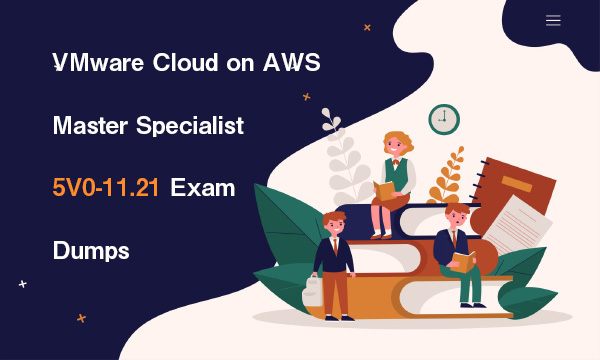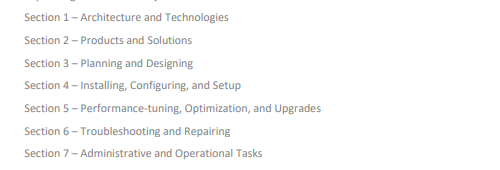VMware Cloud on AWS Master Specialist 5V0-11.21 Exam Dumps
October 30,2021 02:18 AM
VMware certification 5V0-11.21 exam is a required test for VMware Certified Master Specialist-VMware Cloud on AWS certification, which designates advanced knowledge of VMware Cloud on AWS service delivery. To earn Master Specialist-VMware Cloud on AWS certification, you need to pass VMware 5V0-11.21 exam successfully. We have cracked the latest VMware 5V0-11.21 exam dumps questions, which are the best training material for you to prepare for the test.

VMware Cloud on AWS Master Specialist 5V0-11.21 Exam
VMware certification 5V0-11.21 exam tests your ability to deploy, configure and manage a VMware Cloud on Amazon Web Services (AWS) infrastructure.
Number of Questions: 65
Duration: 130 minutes
Passing Score: 300
Format: Single and Multiple Choice, Proctored
Price: $250
Language: English
VMware 5V0-11.21 Exam Objectives
VMware certification 5V0-11.21 exam objectives cover the following details.

Practice VMware Certification 5V0-11.21 Exam Dumps
5V0-11.21 VMware Cloud on AWS Master Specialist exam dumps are the best material for you to test all the above exam objectives. Share some VMware Certification 5V0-11.21 exam dumps questions and answers below.
1.What are three possible reasons that would prevent virtual machines from migrating to VMware Cloud on AWS using VMware vSphere vMotion? (Choose three.)
A. The virtual machine (VM) remote console is open.
B. VMware Tools are NOT installed.
C. The virtual machine (VM) is a linked clone.
D. Paravirtual SCSI disks are mounted.
E. Virtual serial ports are connected with network output.
F. Remote devices are attached.
Answer: B,C,D
2.An administrator deploys a normal (non-stretched) cluster of six i3en.metal hosts in VMware Cloud on AWS. When deploying virtual machines to this cluster, which two of the listed storage policies would satisfy the service-level agreement (SLA) for a six host cluster? (Choose two.)
A. Failure to tolerate = 2 failures - RAID-6 (erasure coding)
B. MC Workload Storage Policy - <cluster name>
C. Site disaster tolerance = Dual Site Mirroring
D. Failure to tolerate = 1 failure - RAID-1 (mirroring)
E. Failure to tolerate = 1 failure - RAID-5 (erasure coding)
Answer: A,C
3.What is a key functionality of the vRealize Automation Cloud Service Broker?
A. Creates and deploys virtual machines, applications, and services to multiple clouds.
B. Automates the DevOps release lifecycle.
C. Provides a common catalog for easy consumption on VMware Cloud.
D. Manages blueprints as a code in a YAML format.
Answer: C
4. Standard security practice for a company requires that all administrator-level user accounts have their passwords changed every 60 days. The cloudadmin@vmc.local account password is changed by an administrator through the VMware vSphere Cliento adhere to the security policy. When the administrator attempts to log into the VMware Cloud on AWS vCenter Server through the VMware vSphere Client a few days later as cloudadmin@vmc.local using the account credentials copied from the VMware Cloud console, the administrator's access is denied. What is the likely cause of this issue?
A. The cloudadmin@vmc.local account password should not be changed through the VMware vSphere Client. In order to prevent unauthorized access to VMware Cloud on AWS by non-authorized individuals, VMware will lock the account out.
B. When the password for cloudadmin@vmc.local is updated from the VMware vSphere Client, the updated password is not reflected in the VMware Cloud console.
C. The cloudadmin@vmc.local password change confirmation email has not been approved by an Organization Owner.
D. The cloudadmin@vmc.local account password should only be changed through the appliance management interface of the VMware vCenter Server.
Answer: B
5.Which two statements are true about the characteristics of the Default Storage Scale-Out policy? (Choose two.)
A. The Default Storage Scale-Out policy storage threshold level is set to meet SLA requirements and can not be superseded by other Elastic DRS policies.
B. The Default Storage Scale-Out policy thresholds for CPU or memory usage are set higher than the other Elastic DRS policies.
C. When the storage threshold of the Default Storage Scale-Out policy has been resolved. Elastic DRS automatically performs a scale-in operation.
D. The Default Storage Scale-Out policy storage threshold is set 5% higher than the other Elastic DRS storage policies.
E. Elastic DRS automatically sets to the Default Storage Scale-Out policy, adding hosts only when storage utilization exceeds a certain threshold.
Answer: A,E
5V0-11.21 Exam Dumps PDF & SOFT | 1 Year Free Update | Money Back Guarantee
- Related Suggestion
- VCP6-5-DCV 2V0-622 Test: Everything you should know about it- by CertQueen December 16,2017
- Passing 5V0-43.21 Exam to Earn VMware NSX Advanced Load Balancer (Avi) for Operators Skills Certification November 15,2024
- Passing 2V0-41.24 Exam to Earn VCP-NV 2024 Certification September 30,2024
- 5V0-35.21 VMware vRealize Operations Specialist Exam Updated Dumps May 15,2024
- Online VMware 2V0-91.22 Exam Dumps Help You Earn VCP-EWS 2024 Certification April 26,2024

